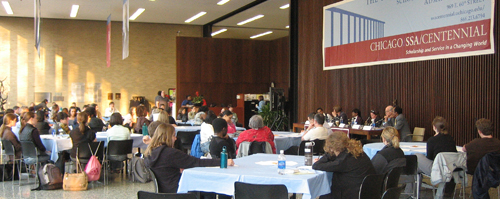| Sun | Mon | Tue | Wed | Thu | Fri | Sat |
|---|---|---|---|---|---|---|
| 1 | 2 | 3 | 4 | 5 | ||
| 6 | 7 | 8 | 9 | 10 | 11 | 12 |
| 13 | 14 | 15 | 16 | 17 | 18 | 19 |
| 20 | 21 | 22 | 23 | 24 | 25 | 26 |
| 27 | 28 | 29 | 30 | 31 |
CATEGORIES
RECENT ENTRIES
BLOG ROLL
Neighborhood vacancy

Foreclosure filings in Chicago rose 100.5 percent from 2006 to 2008, according to a flyer that greeted students and community members at the entrance to the SSA’s Community Economic Development Organization dinner last Tuesday. At the dinner, representatives from the city and four neighborhood organizations shared strategies for foreclosure relief. While the city is buying abandoned units—widely considered harmful to neighborhoods—community organizations also emphasize foreclosure prevention through workshops and homeowner assistance.
In January Chicago received $55.2 million in stimulus money from the federal HUD Neighborhood Stabilization Program (NSP) to buy foreclosed properties in 25 “areas of greatest need”—identified using the program’s rules, explained Ellen Sahli from the city’s Department of Community Development. Chicago's abandoned properties were recently valued at $1.2 billion, Sahli noted, so the city must spend the stimulus money strategically because it “will not be enough to tackle all the vacant properties.” City officials will work with Mercy Portfolio Services to connect with neighborhood developers to rehab the properties, ensure they are up to code, and find occupants. “The role of the city is convener,” Sahli said, “and the role of community partners is to get properties into productive use.”
The other side of foreclosure relief—prevention—has been taken up by organizations across the city. Bruce Gottschall of Neighborhood Housing Services and Reverend Rodney Walker of Teamwork Englewood described their organizations’ work, such as mediating between lenders and homeowners and advocating in Springfield for legislation like HR 0521, which would authorize state funds for foreclosure-prevention counseling. Guacolda Reyes of the nonprofit Resurrection Project described a March workshop in which some 600 families met with potential lenders face-to-face. Reyes was frustrated that Resurrection Project’s neighborhoods aren’t on the city’s list—instead it has turned to statewide NSP funds—but condoned the city’s decision to work with Mercy Portfolio. “The city’s strategy of having one negotiator will have a good effect on the rates people get from lenders for their homes,” she said.
Chicago is addressing the foreclosure crisis through federal funds, city planning, and local organizations. Woodlawn East Community and Neighbors director Mattie Butler even sees an opportunity for her community to end up better off than it was “before the bottom fell out.” The city-community partnership, she believes, will help reinstate the area’s affordable housing. Woodlawn “lost a lot of affordable units during the area’s upward mobility to condos that are now empty,” she said. “We’re going to recapture those and make them affordable again.”
Shira Tevah, ’09
RELATED READING
- " Westward How?" (University of Chicago Magazine, Nov-Dec/08)
- "Hyde Park snark" (UChiBLOGo, May 8, 2009)
May 13, 2009
